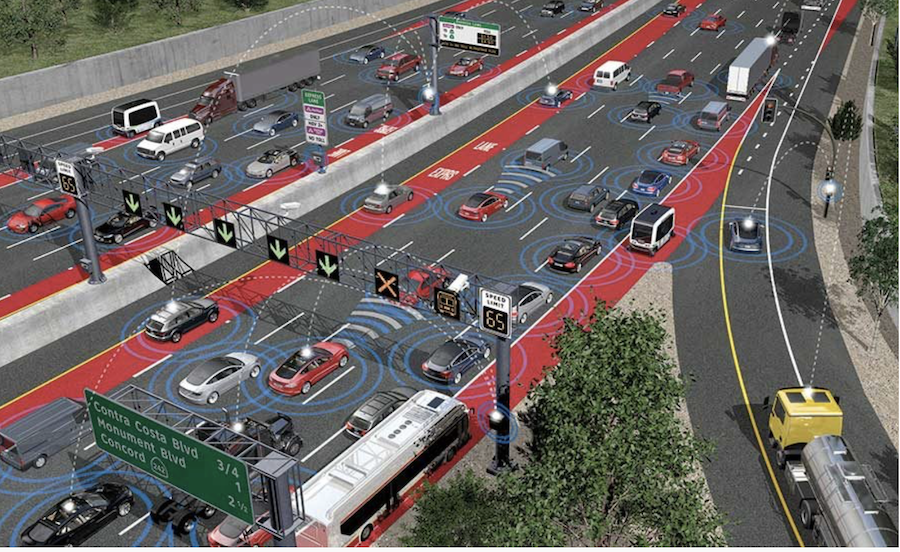At a pared-down version of this year's Transportation Research Board conference in Washington, D.C., attendees were pleased by passage of the $1-trillion federal infrastructure finance package, but transportation officials are also concerned about how the funding will actually roll out and how agency missions will adapt in a post-pandemic world.
The first TRB event held since enactment of the Infrastructure Investment and Jobs Act last November featured transportation agency officials discussing both the opportunities and challenges afforded by the added funding, particularly given uncertainties of the post-pandemic economy.
“Transportation agencies were evolving for years long before the pandemic,” said Stephanie Pollack, deputy administrator od the Federal Highway Administration at the event, held Jan. 9-13. “The future has changed on us.” She noted that “transit [officials] are using this opportunity to ask questions about what transit can be.”
Pollack, who moderated a panel of U.S. Transportation Dept and state agency leaders, says FHWA is trying to streamline its documentation process by holding early-on policy workshops so that all stakeholders involved can provide comments. “We cannot put out documents or get anything done if the process is linear,” she said.
The goal is not simply to get projects moving quickly, Pollack added. “This is not ARRA 2.0,” she said, referring to the 2009 American Recovery and Reinvestment Act srimulus program. “It’s about getting it right … not just shovels in the ground. As an industry, we tend to measure funds as if they are the outcome. They are inputs. Roads, bridges, transit—those are the outputs.”
Leslie Richards, General Manager for the Southeast Pennsylvania Transit Authority, noted that her agency’s $120-million allotment from the bill will likely be used up before system ridership returns to pre-pandemic levels.
“We have to operate more efficiently,” Richards said, adding that SEPTA and other transit agencies will also have to become less commuter-driven, adapting to the pandemic-accelerated trend toward flexible work schedules.
Julie Lorenz, secretary of the Kansas Dept. of Transportation, said that her agency has been looking at various scenarios and consulting with municipalities and contractors in the state to gain input on actions to improve the transportation system, rather than just creating an arbitrary list of projects. For example, “we have 23,000 bridges … we don’t need all these bridges, just stronger ones in some places,” she said. “But it’s not my role to say, ‘get rid of these three bridges.’”
Gregory Pecoraro, president and CEO of the National Association of State Aviation Officials, said the group's members are “ramping up to find grant specialists” in anticipation of infrastructure law funding opportunities. But the Federal Aviation Administration also needs to streamline its processes, he added.
Making Connections
Inclusion and equity, recovery and resilience, and technology also were on the agenda at TRB.
Shawn Wilson, Louisiana Dept. of Transportation and Development secretary and the first Black president of the American Association of State Highway and Transportation Officials, noted in a session he moderated on equity, that there are six Black state DOT leaders, the most in U.S. history.
“We must go from symbolic to systemic,” said Toks Omishakin, director of the California Dept. of Transportation. He said Caltrans has engaged in equity listening sessions with community leaders, including homeless advocates, and is requiring all employees to participate in an implicit bias program.
With a state $1.2-billion initiative expected to complement federal infrastructure funds, “we are going to hire a ton of people in the next three years,” he said. That includes recruiting from homeless people, ex-convicts and those from disadvantaged communities, and making sure hiring committees are diverse, he said.
Yassmin Gramian, secretary of the Pennsylvania Dept. of Transportation, said it is working with other state agencies such as the Dept. of Human Services to reach out to historically underserved communities. Noting, as an example, the bifurcation of Philadelphia’s Chinatown section due to a highway project, she said, “the people most in need of transportation don’t have the time to advocate for themselves.”
Technology Roll-out
Although initial public hype surrounding autonomous vehicles has cooled in light of lingering safety concerns and a still-evolving regulatory process, transportation researchers continue to explore planning and operational issues that policymakers will need to consider for the technology’s eventual roll-out.
Multiple TRB sessions touched on issues such as wireless infrastructure limitations in rural areas, curbside management for pick-ups/drop-offs, ensuring transportation equity with shared autonomous vehicle services and limiting effects of “empty trip” AVs on road network congestion.
Robert Heilman, director of the federal DOT’s Highly Automated Systems Safety Center of Excellence, discussed some new programs being established to eventually provide a conduit of federal funding support for new and emerging AV technology research. Among them is what Heilman described as a planned unit—similar to the Defense Advanced Research Projects Agency (DARPA) in the US Defense Dept.—for infrastructure research that, while currently unfunded, is “looking for wild ideas.”
John Harding, leader of the DOT Office of Transportation Management’s Connected/Automated Vehicles and Emerging Technologies Team, briefed TRB session attendees on the complicated efforts to ensure safe integration of AV technologies with existing infrastructure as they evolve from driver-assist capabilities to full automation.
TRB presenters noted the importance of solid planning to use new funding efficiently and effectively.
Peter Schwartz, chief,of the Federal Railroad Administration's project engineering and transportation planning division, noted that the funding program's size and scope made it “a hard bill to pass.” Unless the public perceives it is receiving value from that investment, a follow-up may be a long time in coming.
“We have a huge opportunity,” Schwartz said. “If we squander it, we may not get another chance.”
Asked what he thought industry could be discussing in five years, aviation group CEO Pecoraro responded that he hoped it would not be “How did we blow it with the infrastructure bill? Why didn’t we take advantage of it for a far bigger impact?”






